Foreign and Commonwealth Office
|
||||||||||||||||||||||
|
||||||||||||||||||||||
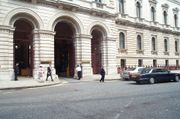
Entrance to the Foreign and Commonwealth Office
|
||||||||||||||||||||||
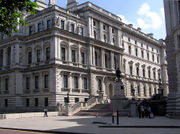
The Foreign and Commonwealth Office, Whitehall, seen from St. James’s Park
|
||||||||||||||||||||||
The Foreign and Commonwealth Office, commonly called the Foreign Office or the FCO, is the British government department responsible for promoting the interests of the United Kingdom overseas, created in 1968 by merging the Foreign Office and the Commonwealth Office.
The head of the FCO is the Secretary of State for Foreign and Commonwealth Affairs, commonly abbreviated to "Foreign Secretary" (currently William Hague). This position is regarded as one of the three most prestigious appointments in the Cabinet, alongside those of Chancellor of the Exchequer and Home Secretary. Together with the Prime Minister, these comprise the Great Offices of State.
The Acting Permanent Under-Secretary and Head of the Diplomatic Service is Martin Donnelly, a senior civil servant will be replaced at the end of August 2010 by Simon Fraser[1]
Contents |
Ministers
- Secretary of State for Foreign and Commonwealth Affairs – William Hague MP (Conservative)
History of the department
The department's origins
The FCO was formed in 1968, from the merger of the short-lived Commonwealth Office and the Foreign Office. The Commonwealth Office had been created only in 1966, by the merger of the Commonwealth Relations Office and the Colonial Office, and the Commonwealth Relations Office had been formed by the merger of the Dominions Office and the India Office in 1947—with the Dominions Office having been split from the Colonial Office in 1925.
The Foreign Office was formed in March 1782 by combining the Southern and Northern Departments of the Secretary of State, each of which covered both foreign and domestic affairs in their parts of the Kingdom. The two departments' foreign affairs responsibilities became the Foreign Office, whilst their domestic affairs responsibilities were assigned to the Home Office.[6]
Developments
When David Miliband took over as Foreign Secretary in June 2007, he set in hand a review of the FCO’s strategic priorities. One of the key messages of these discussions was the conclusion that the existing framework of ten international strategic priorities, dating from 2003, was no longer appropriate. Although the framework had been useful in helping the FCO plan its work and allocate its resources, there was agreement that it needed a new framework to drive its work forward.
The new strategic framework consists of three core elements:
- A flexible global network of staff and offices, serving the whole of the UK Government.
- Three essential services which:
- support the British economy
- support British nationals abroad and
- support managed migration for Britain.
These services are delivered through UK Trade and Investment (UKTI), consular teams in the UK and overseas, and the UK Border Agency (UKBA).
- Four policy goals to:
In August 2005, a report by management consultant group Collinson Grant was made public by Andrew Mackinlay. The report severely criticised the FCO's management structure, noting that:
- The Foreign Office could be "slow to act".
- Delegation is lacking within the management structure.
- Accountability was poor.
- 1200 jobs could feasibly be cut.
- At least £48 million could be saved annually.
The Foreign Office commissioned the report to highlight areas which would help it achieve its pledge to reduce spending by £87 million pounds over three years. In response to the report being made public, the Foreign Office stated it had already implemented the report's recommendations. [1]
In April 2006 a new executive agency was established, FCO Services, to provide corporate service functions. In April 2008 it moved to Trading Fund status so it had the ability to provide similar services which it already offers to the FCO, to other government departments and even outside businesses.
On 25th April 2010, the department apologised after The Sunday Telegraph obtained a "foolish" document calling for the upcoming September visit of Pope Benedict XVI to be marked by the launch of "Benedict-branded" condoms, the opening of an abortion clinic and the blessing of a same-sex marriage. [7]
History of the Foreign and Commonwealth Office main building
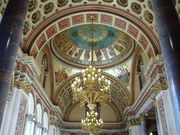

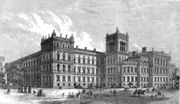
The Foreign and Commonwealth Office occupies a building which originally provided premises for four separate government departments: the Foreign Office, the India Office, the Colonial Office, and the Home Office. Construction on the building began in 1861 and finished in 1868, and it was designed by the architect George Gilbert Scott.[8] Its architecture is in the Italianate style; Scott had initially envisaged a Gothic design, but the then Foreign Secretary Lord Palmerston insisted on a classical style.[8] (Palmerston was Prime Minister at the time the building was begun, in 1861, not Foreign Secretary, a post that he had not held since 1851.) English sculptors Henry Hugh Armstead and John Birnie Philip produced a number of allegorical figures ('Art', 'Law', 'Commerce', etc.) for the exterior.
In 1925, the Foreign Office played host to the signing of the Locarno Treaties, aimed at reducing tension in Europe. The ceremony took place in a suite of rooms that had been designed for banqueting, which subsequently became known as the Locarno Suite.[9] During the Second World War, the Locarno Suite's fine furnishings were removed or covered up, and it became home to a foreign office code-breaking department.[9]
Due to increasing numbers of staff, the offices became increasingly cramped and much of the fine Victorian interior was covered over—especially after World War II. In the 1960s, demolition was proposed, as part of major redevelopment plan for the area drawn up by architect Sir Leslie Martin.[8] A subsequent public outcry prevented these proposals from ever being implemented. Instead, the Foreign Office became a Grade 1 listed building in 1970.[8] In 1978, the Home office moved to a new building, easing overcrowding.
With a new sense of the building's historical value, it underwent a 17-year, £100 million restoration process, completed in 1997.[8] The Locarno Suite, used as offices and storage since the Second World War, was fully restored for use in international conferences. The building is now open to the public each year over Open House Weekend. The Foreign and Commonwealth Office is now also the main tenant of the Admiralty Extension building, at the opposite end of Horse Guards Parade.
List of Foreign and Commonwealth Office home properties
- FCO Main Building, Whitehall, King Charles St, London (abbreviated to KCS by FCO staff)
- Kirkland House, 22-24 Whitehall, London.
- Old Admiralty Building, Whitehall, London (abbreviated to OAB by FCO staff)
- Hanslope Park, Hanslope, Milton Keynes (abbreviated to HSP by FCO staff). Location of FCO Services, HMGCC and Technical Security Department of the UK Secret Intelligence Service)
Devolution
International relations are, by necessity, handled centrally from Westminster on behalf of the entire UK. However, the devolved administrations also maintain an overseas presence in the European Union and the USA alongside UK diplomatic missions:
European Union
- Scotland House (Brussels)
- Wales House (Brussels)
- Office of the Northern Ireland Executive in Brussels
USA
- Scottish Affairs Office (Washington DC)
- Welsh Assembly Government External Affairs Department (New York)
- Northern Ireland Bureau (Washington DC)
These offices aim to promote their regional economies and ensure that devolved interests are taken into account in UK foreign policy. Devolved ministers can attend international negotiations when permitted by the UK Government e.g. EU fisheries negotiations. [10]
UK and devolved ministers meet at approximately quarterly intervals through the Joint Ministerial Committee (Europe), chaired by the Foreign Secretary to "discuss matters bearing on devolved responsibilities that are under discussion within the European Union."
See also
- Secretary of State for Foreign and Commonwealth Affairs
- Secretary of State for Commonwealth Affairs
- Secretary of State for Commonwealth Relations
- Secretary of State for Dominion Affairs
- Her Majesty's Diplomatic Service
- List of heads of missions from the United Kingdom
- Department for International Development
- List of diplomatic missions in the United Kingdom
- List of diplomatic missions of the United Kingdom
- Diplomacy
- Ambassador
- Court of St. James's (to which foreign ambassadors to Britain are accredited)
- Know Before You Go Campaign
- Foreign Office condom insult
References
- ↑ http://www.telegraph.co.uk/news/newstopics/politics/7920336/New-Foreign-Office-chief-Simon-Fraser-left-job-over-love-affair-with-PLO-official.html
- ↑ http://www.fco.gov.uk/en/about-us/who-we-are/our-ministers/jeremy-browne
- ↑ http://www.fco.gov.uk/en/about-us/who-we-are/our-ministers/david-lidington
- ↑ 4.0 4.1 "Her Majesty’s Government". Prime Minister's Office. http://www.number10.gov.uk/news/latest-news/2010/05/her-majestys-government-49840. Retrieved 19 May 2010.
- ↑ http://www.fco.gov.uk/en/about-us/who-we-are/our-ministers/alistair-burt1
- ↑ A brief history of the FCO Foreign and Commonwealth Office
- ↑ http://news.bbc.co.uk/2/hi/uk_news/8642404.stm
- ↑ 8.0 8.1 8.2 8.3 8.4 Foreign & Commonwealth Office History
- ↑ 9.0 9.1 Foreign & Commonwealth Office: Route
- ↑ Scottish gains at Euro fish talks, Scottish Government, 16 December 2009
External links
- Official website
- FCO Blogs
- Britain in the EU (FCO)
- Official website of FCO Services (Executive Agency)
- Official FCO/Immigration Service website
- FCO Flickr site
- FCO YouTube site
- FCO Twitter directory listing all our Twitter sites
- Know Before You Go Campaign Site
|
||||||||||
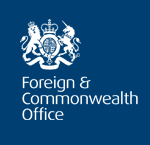
.svg.png)